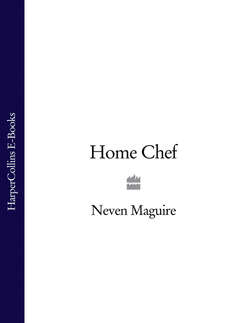Читать книгу Home Chef - Neven Maguire - Страница 52
Choosing Meat
ОглавлениеA good butcher is invaluable; a shop run by helpful, knowledgeable staff inevitably means they care about the meat they stock and will have treated it properly. They should be able to advise you about cooking times and recommended methods as well as prepare joints and steaks to your requirements.
Meat should always look and smell fresh. A bright red or pink doesn’t necessarily indicate freshness. Instead, look for a good, clear colour; although bear in mind that it will darken naturally on exposure to air. Beef should be well hung for a better flavour. Look out for labels stating that the meat has been ‘dry aged’. This means that 30 per cent of the moisture has been removed and as a result the beef should be firm to the touch.
Any fat should be creamy white; if it’s yellow (except for some very specialist breeds), the meat is probably past its prime. Look for a smooth outer layer of fat, if appropriate to the cut, and a fair amount of ‘marbled’ fat distributed throughout the meat; this will keep it moist during cooking and add flavour.
Always look for a neat, well-trimmed piece of meat, with sinew removed. Splinters of bone and ragged edges indicate poor butchery. Joints and steaks should be of uniform thickness so that they cook evenly.
Minced meat is best eaten on the day of purchase. Larger joints, chops and steaks will keep for 2-3 days. Lean cuts will keep for longer as it is the fat that turns rancid first. If in doubt, smell it – ‘off’ meat will have an unpleasant odour and a slimy surface.
I always remove meat from its original wrapping and then put it, wrapped in fresh cling film, on a plate in the fridge to prevent blood dripping through the fridge shelves. Remember to always store raw meat away from cooked foods to prevent cross-contamination. As a general rule, remove meat from the fridge 30 minutes to 1 hour before you intend to use it. This allows it to relax and return to room temperature. Once cooked, rest it once more so that the juices stay in the meat after it is cut. »
In Ireland we are lucky enough to have a Quality Assurance scheme run by Bord Bia, the Irish food board, who are committed to supporting Irish farmers and the industry to produce the safest and highest quality food possible. Bord Bia have tirelessly championed Irish meat abroad and have been responsible for allowing artisan businesses to blossom and expand under their watchful eye. Look out for their quality mark- a shamrock with an Irish flag. It guarantees that the meat can be traced back to the farm on which the animal was reared.
